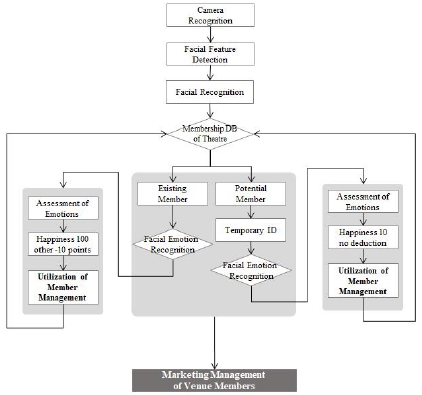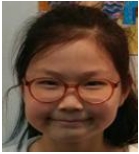
A Proposal on the Performing Arts Center's Membership Management System Using Face Recognition Technology
Copyright ⓒ 2018 The Digital Contents Society
This is an Open Access article distributed under the terms of the Creative Commons Attribution Non-CommercialLicense(http://creativecommons.org/licenses/by-nc/3.0/) which permits unrestricted non-commercial use, distribution, and reproduction in any medium, provided the original work is properly cited.

Abstract
This study proposed the membership management system for performing arts center using face recognition technology. This is a method of recognizing the facial emotion of all the visitors entering the performing arts center and it is adding or subtracting the mileage points in real time according to the emotion by a numerical value. Once the face of many people in the performing arts center is recognized by the camera, the administrator can grasp the history of existing member's purchased tickets for performing arts by analyzing the first information in the performance member DB while detecting the facial feature via the camera. Potential members have been registered by administrator arbitrarily using a "Guest ID" with detecting the facial feature. Afterward, the emotion recognition based on the detected face can be applied for member's mileage according to feelings such as anger, contempt, discomfort, fear, happiness, indifference, sadness, surprise. In the future, it will be possible to provide high-level cultural arts-related services.
초록
본 연구에서는 얼굴인식기술을 이용한 공연장 회원관리 시스템을 제안하였다. 이는 공연장에 출입하는 모든 관객들을 대상으로 얼굴 감정을 인식하고 수치화된 감정에 따라 실시간으로 마일리지 포인트를 가감하는 방식이다. 공연장에 있는 많은 사람들의 얼굴을 카메라가 인식하여 기존회원인 경우는 얼굴특징 검출과 동시에 공연장 회원 DB에서 1차 정보 분석을 하여 기존 공연 관람 이력 등을 관리자가 파악할 수 있다. 잠재회원인 경우는 얼굴특징을 검출하면서 Guest ID를 사용하여 임의로 등록을 한다. 이후 검출된 얼굴을 바탕으로 감정인식을 하여 분노, 경멸, 불쾌, 두려움, 행복, 무관심, 슬픔, 놀라움 등 8가지의 기본 감정의 수치에 따라 회원마일리지를 부과한다. 향후, 파악한 정보를 세분화하여 회원들의 성향에 맞는 수준 높은 문화예술관련 서비스를 제공 할 수 있다.
Keywords:
Member Management System for performing arts center, Facial Emotion Recognition, Performing Arts Center's Marketing키워드:
공연장 회원관리시스템, 얼굴감정인식, 공연장 마케팅Ⅰ. Introduction
Recent advances in ICT technology have made it necessary for safer security technologies. Security technologies that have been used so far have low security with the disadvantages of theft and loss of the user authentication type electronic password and ID card, but biometric technologies have unique and unchanged characteristics of each person complementing the disadvantages of traditional methods with a higher convenience. In particular, biometric technologies such as face recognition, iris recognition and fingerprint recognition, which were only seen in movies, have become so common that they are now used in finance, computers, information system security, telecommunication management, access management and public [1][2].
China aims to become a global advanced country in the field of artificial intelligence in 2030 and develops biometric computer-artificial intelligence that can automatically recognize human faces from a digital image database to provide various fields such as public safety, finance, transportation and retail.
In particular, China uses face recognition technology from arresting suspects of police criminals to ATMs on the streets, which are permeating daily life in China. According to Chinese police in Zhengzhou, which introduced smart glasses with face recognition technology, the local police said, "It is not necessary to ask for ID cards or to take them to the police station like before." After taking photos of people via smart glasses, he said that he could arrest a criminal by comparing the photos to the criminal databases [3].
In Spain, there is the performing arts center that was the first in the world to introduce the "PAY PER LAUGH", which costs an additional fee of 0.3 euros (KRW400) each time the audience laughs at a comedy performing arts center [4]. That is, it installs an iPad with software that recognizes facial expressions for each seat in a performing arts center. It analyzes emotions of the audience's face whenever the audience laughs and then finally the audience charges the bill. Of course, there is a limit of up to 24 euros per person (30,000 won) for the extra fee. It was favourably received by audiences at the performing arts center, and consequently, the audience increased by 35% and it was also successful in improving the quality of the performances.
The performing arts center, which is an important place in the performing arts field, not only builds a system that can utilize various technological convergence for the 4th Industrial Revolution era but also manages the memberships for the sustainable audience management of the performing arts field. Consequently, it has became essential for fields of performing arts.
However, the use of ICT technology in Korean performing arts is still at the basic stage. For example, Kakao has recently entered the performance art market platform business, signalling a future-oriented wave, and the field of performing arts has the basic technical standard that allows the entering system of the barcode and QR code via smartphone and the unmanned checking system using IOT, which is already used in various IT sectors within two or three years. Of course, this study may be about the technological environment that is ahead of the times in the performing arts, but as the face recognition, facial expression recognition, and biometry are already used in a wide range of industries. So, it can be the right attitude for the performing arts industry.
With the growth of culture and art industry in the 21st century, many cultural and artistic performing arts centers are in a competitive environment to enhance their self-reliance, and therefore audience-oriented marketing strategy is essential. Moreover, it is a necessary strategy and a key factor in economic profit to make both new and potential audiences to join membership due to the nature of the performing arts center.
Thus, the performing arts center needs to have a strategy of CRM(Customer Relationship Management) which can enhance the satisfaction of the audience and establish an intimate and friendly relationship with the audience in order to maintain the existing audience as well as to attract more new audiences. This is to avoid the transaction-oriented concept of traditional cultural content sales and strengthen cultural and social ties with audiences (customers) so that it is in urgent need for a more effective and efficient member system improvement plan because of the economic benefits.
Therefore, this paper will propose a membership management system for performing arts center using face recognition technology. Firstly, this paper will summarize the definitions and concepts of face recognition technology and performing arts center's membership management for prior research and theoretical discussion. In addition, this paper will examine the definition and concept of membership management system and the merits of this system in terms of the performing arts center 's mileage membership system. Lastly, in terms of suggestions for membership management, this essay will propose an effective membership management system with the flowchart of the performing arts center membership management system by means of expected effect.
Ⅱ. Literature Review
2-1 The concept of face recognition technology and the performing arts centre's membership management system
Face recognition has two functions including face verification and face identification. The former aims to determine whether two given faces are the same person. The latter is to find the identity of a given face in a set of known faces. Recently, many deep-running algorithms have shown excellent results in these two face recognition functions.
Huang et al. proposed learning hierarchical representations for face verification with convolutional deep belief networks [5].
Taigman et al. proposed a three-dimensional face model based on facial alignment algorithm and facial expression learned by DNN of 9 layers [6]. Sun proposed a so-called Deep hidden function(DeepID) for face verification [7].
In the last decades, image classification has been an active research topic [8]. There are several methods that proposed, including spatial pyramid matching [9], Bayesian hierarchical model [10], part-based model R [11], and sparse coding [12].
However, these methods use hand-crafted features that cannot capture raw pixel values or data-based representations of specific input data. In these days, deep running has shown very good results in image classification.
This technology can be applied to artistic and cultural fields. The membership management system in performing arts centre is one of the marketing strategies to increase the loyalty of the audience who mainly purchase the art products of the performing arts. It is a strategy to establish an intimate and friendly relationship by maintaining the relationship with the audience in the long term and providing a better quality of artistic products by collecting diverse customer's opinions. In particular, the membership management system plays a role in inducing the development of new audiences in the performing arts and securing various information of existing and new audiences. Through effective communication with audiences, performing arts in performing arts center can be induced.
The membership management system is intended to give an audience the chance to enjoy the culture through the best services and various benefits for the performing arts. So, it is possible to find the ultimate goal and to purchase the ticket continuously or maintain the fixed audience.
In general, performing arts centers are attracting members who are interested in performing arts, although there are many other cultural and artistic genres. In order to increase the satisfaction of the audience and the loyalty of the permanent audience, performing arts centre collects the personal information about the audience including tendency or preference toward the performing arts. Therefore, it is possible to provide various benefits to the audience when planning and operating the various programs in performing art centre through the DB of the audience, and it can be essential for the stable operation of the performing arts center[13]. The operation of the performing arts center by collecting a database of the audience can be defined as the operation of customer relationship management(CRM). However, the purpose of CRM is not merely to acquire and develop new audiences but also to obtain financial benefits. In other words, it includes step-by-step growth from a loyal audience through an acquisition of new audiences and purchase tickets for performance work with a high quality and quantity [14].
According to the Baek(2012), even if some of the public performing arts centers at Seoul tend to use the membership management system, it is difficult to manage and analyze the membership information that can be used as a marketing strategy due to limited information of audiences[15].
Therefore, it is necessary to construct loyal members by recognizing the favourite genres of the audience and reflecting them to the performing arts hall as much as possible in order to manage the members more effectively. In other words, it is also a strategic management method that can increase the financial income portion of the performing arts center.
2-2 The merits of a performing arts center 's mileage membership management system
Mileage membership system among various performing arts center 's membership system is a more efficient management system to maintain the loyalty of customers continuously. The mileage system refers to a marketing strategy that continuously maintains and strengthens consumer's loyalty to the company by returning part of its profits from selling its products or services to customers in the form of points reserve, coupon, or cash. In other words, it is defined as a system that manages and operates a customer as a membership system and provides mileage according to the customer's usage record points, and then provides corresponding benefits based on predetermined criteria when the accumulated mileage reaches a predetermined standard.
In addition, the mileage system provides corresponding compensation and maintains a constant and regular relationship as the customer's ongoing transaction or cumulative transaction volume increases. Therefore, it has a loyalty to the company or product. According to the customer's continuous transaction, the company obtains the basic information about the customer, and the customer can obtain information about the product which they prefer. Moreover, the identified information can be used to maintain a lasting relationship with the customer to prevent the customer from leaving and to re-activate the existing customer.
In general, mileage type classification can be divided into classification depending on the earning method, the usage method, and criteria for the standardization and universality of the benefit that the mileage company provides to the client.
For example, there is the point system of LG Arts Center. LG Arts Center does not have a membership fee or annual fee, unlike other performing arts center members' membership system, and operates a membership system that earns discounts depending on how many time audiences watched performing arts through the accumulation of mileage points called 'Art Points'. Membership can be subscribed through the Internet. If the audience register, 5% of art points will be accumulated when the customer watched to the performing arts. <Table 2> shows a detailed description of Art Points. In terms of unique features, an audience can get free meal coupons for art points instead of discounts from an affiliated company.
As it mentioned earlier, the mileage system is a marketing strategy that aims to increase the future value of a company and to maintain and enhance consumer's loyalty to the company. In other words, mileage system is a system that provides mileage according to customers' usage results and provides various rewards to consumers based on mileage accumulated based on certain criteria. Due to the diverse needs of consumers, companies are trying to emphasize the need to maintain existing customers rather than strategies to attract new customers.
In particular, it is wise to continue to sell products and services to existing customers in order to increase the profit of the company against limited consumers [18]. The mileage system has two main purposes [19]. Firstly, by providing corresponding compensation in proportion to the customer's continuous transaction or transaction volume, the customer is kept loyal to the company by continuously maintaining the transaction. The second one is to maintain customer relations with customers by acquiring customer information to join the mileage system and providing services to individual customers.
This can prevent the customer from leaving in advance and fulfill the purpose of restoring already existing customers.
Ⅲ. A Proposal for Membership Management in Performing Arts Centre Using the Face Recognition Technology
3-1 A Proposal of the Performing Arts Center's Membership Management System
The purpose of this study is to manage efficiently membership of the performance performing arts center by applying face recognition technology to a performing arts center 's membership management system. This can be an opportunity to break away from the performing arts market, which is shrinking due to the economic downturn and the enforcement of the Improper Solicitation and Graft Act.
According to the survey of the performing art in 2017, rate of operation in performing arts center decreased to 60.8% in 2016 more than that of 2015, and it decreased with the gap of 11.7% comparing that of 2013. Therefore, it is time to manage to establish an intimate and friendly relationship with audiences in order to retain existing members and secure new members in terms of the performing arts center. Of course, there are various ways to do this, however, it is necessary to attract audience members by using face recognition technology to focus on 'fusion of technology and art' which is becoming a hot topic these days. As a research method, this study use face recognition technology via using Microsoft Project Oxford. This program is a project that uses Microsoft's machine learning technology so that anyone can use the machine learning technology API if registry. That is, it is an open source program that anyone can use.
This is a demonstration program, but it is of utility value of that as it gives the impression that Microsoft is not lagging behind in the field of machine learning through Project Oxford. Of course, it is also possible to use a more effective paid program than Project Oxford(MS) in the performing arts center. But, it is choosed by the study in that everyone can choose to use easily the program. The proposal for the management of a theater using face recognition technology is as follows. This is a method of recognizing the facial emotion of all the visitors entering the hall and adding or subtracting the mileage points in real time according to the emotional emotion.
Due to the fact that the general performing arts center 's membership management system is a regular membership system, it can be divided into a free membership system and a paid membership system. The former only collects and manages the simple information of members, and regularly distributes newsletters and promotional pamphlet to the program.
On the other hand, the latter can pay an annual fee for a season, receive discounts on their chosen performances, and purchase tickets in preference to regular audiences. Most performing arts centers offer benefits such as ticket discounts, free program books, free parking tickets, as well as graded services. However, this study utilizes not the regular membership management system but the aforementioned mileage member management system.
In other words, it is the membership management system of performing arts center that uses face recognition technology. Face recognition technology has already reached a stage where the emotion of a human face can be quantified and displayed through images. In particular, a program called "Microsoft Project Oxford" developed by Microsoft Corporation is a project that uses machine learning to obtain useful data from photographs, voice, and video [20]. According to Microsoft, this program provides a total of 8 emotions (anger, disdain, disgust, fear, happiness, expression, sadness, surprise) and also it shows numerically the data and consequently, the highest figure can be grasped as the final emotion. There are two types like Table 3 and Table 4 depending on the gender. 1)
In Table 3 and Table 4, there is an image in which the numerical values are clearly high and an image that has the various emotions with various numerical values. For example, in Table 3, No 3's image has very small differences, such as Contempt 0.38073, Happiness 0.37462, and Neutral 0.23290. In Table 4, even if Sadness 0.67135 is the highest emotion in image 4, there is a very small numerical difference.
Therefore, since the emotional state in which there is little difference between these numerical values can be derived, the definition of the numerical value for each emotion is arbitrarily determined as follows.
When the maximum emotion value is judged to be 1, the emotion value that does not exceed the minimum value of 0.5 is not included in the mileage point accrual. The reason is that it can not be judged that the emotion having a numerical value of only 0.1 in a state in which the emotion of the numerical value does not exceed 50% does not include all the various emotions. Consequently, when these numerical values are derived, any mileage points neither (-) nor (+) should be applied. Table 5 shows the mileage points according to emotions.
This face recognition technology can be applied to a performing arts center 's membership management system. That is, it recognizes the facial emotion of all audiences entering and leaving at the theater and adds or subtracts the mileage points in real time according to the emotional emotion. Table 5 shows the 'method of mileage point system according to emotions'. Since there are 7 negative factors and 1 positive factor among the total 8 emotions, for example, we imposed +100 points for positive feeling 'happiness' and also -10 points for all feeling except for happiness respectively.
Existing members follow this rule and potential members who do not join to performing arts center will be charged +10 points for happiness and will not be penalized for other emotion recognition. As mentioned before, due to the fact that potential members are not members, after joining the final membership, they need to apply the same rules as existing members. The accumulated mileage point system offers the opportunity to use cash as a bonus according to the various mileage addition and deduction details of the actual performing arts center members. In the case of existing members, performing arts center can provide various discount coupons or free invitation tickets as marketing strategy depending on member's record that has watched performing arts with similar genres or purchased food and beverages in the performing arts hall. Of course, if an audience can share the membership information DB among the performing arts centers or organize the network, they can enjoy more diverse cultural and artistic facilities by using mileage points.
3-2 A proposal for a system flowchart of performing arts center membership management
In order to understand the proposals in the previous chapter, this study presents a flow diagram of a performing arts center membership management system using face recognition technology as shown in Figure 1. Flowchart Figure 1 is divided into the application of face recognition technology and analysis of membership information, and there are overlapping areas. As shown in Figure 1, the performing arts center 's membership management system using face recognition technology is divided into an application of face recognition technology and analysis of membership information, and there are overlapping areas. First of all, in the case of existing member, an officer in marketing team are able to check their record that has watched performing arts by analyzing theater's member DB with detection of facial feature, recognizing audience from many crowds in performing arts center. Secondly, in terms of a potential member(non-registered member), the facial feature is detected and registered arbitrarily using the guest ID. Afterward, emotion recognition is performed based on the detected face, and member mileage is charged according to feelings such as anger, contempt, discomfort, fear, happiness, indifference, sadness, surprise.
On the other hand, the analysis of membership information is carried out from distinguishing existing members and potential members by utilizing a performing arts center's database, and then the analysis of the second member information is progressed while recognizing emotions. Although it is necessary to make a system that the existing members could be added to points for the happiness and subtracted to points in other feelings, the potential members could be imposed on points for the happiness without deducting points from any feelings. This is, because, as mentioned above, potential members can collect all mileage when a potential member becomes a new member through the offline membership process at the end of the analysis of the third member information, and when the member does not want to join, all the mileage will be disappeared.
3-3 Expected effect of membership management system via the proposed face recognition technology
Performing arts center can achieve the following effects through the proposed mileage membership management system based on facial emotion recognition. Firstly, it is possible to develop various event services by inducing members' interest in the field of face recognition technology as compared with the general member management system. For example, a day of laughter, a day of happiness, a day of sadness, etc. may be set for each day of the week, and consequently, a person who has highly added corresponding points of feeling may be given a chance to experience various cultural and arts programs with free and discount coupons. As a result, the member could increase the loyalty of a performing arts center. Also, performing arts center can give audiences who have never felt happy within a limited time a high mileage point as an event. Or, whenever the audience feels happy feelings, performing arts center can issue a campaign event that can be donated to a charitable organization in 1:1 matching between audience's points and campaign's event points. Of course, it could have positive effects on the fields of culture and arts from earning mileage points through face recognition technology and using them.
Secondly, it can automatically raise donations via the face recognition technology. In general, fundraising is a very difficult and cumbersome task, since it means that paid up members of the performing arts centre directly tend to increase their loyalty of a higher level. But, if members of the performing arts center use to utilize the mileage system points as donations so that it will be possible to promote the donation of more active members of the performing arts centre.
Thirdly, if a mileage point system using face recognition technology is applied to museums, galleries as well as national public art centers, many customers could have the opportunity to experience various artistic and cultural programs through 'Art Passes[21]' system that currently provides the public audience with discount benefits.
In conclusion, the performing arts center can directly grasp the preference genre of the members by means of the mileage membership management system, and keep the relationship with the members by subdividing the information they have gained. Consequently, it can provide the member with artistic and cultural programs of a high quality depending on member's tendency. In other words, it is possible to encourage and induce participation in various events such as exhibitions, festivals, etc. based on the member information at performing arts center. Furthermore, audiences will be more curious and more interested in the performing arts centre that uses the special technique of face recognition. This means that the performing arts center will be able to draw the result of profit because of the high ticket purchase of the audience
In addition, it is possible to provide a potential audience with a chance to attract a fixed audience by transmitting a positive image to the audience. Therefore, if the performing arts center actively promotes the combination of face recognition technology and mileage point system, it can provide a more stable audience by making it possible for the audience to utilize the performing arts center continuously. Furthermore, the membership system that utilizes this face recognition technology not only becomes a basis for raising the profit of the program operation through the formation of the fixed audience group by attracting interest but also forms the basis for securing the potential applicant for the financial resources. Fixed audiences in the form of membership are most likely to participate positively in most programs, with great interest in performing arts centers and programs, and are more likely to respond positively to support requests from performing arts centers[11].
Ⅳ. Conclusion
The purpose of this study is to utilize face recognition technology for the efficiency of performing arts centre's member management. Recently, as the field of face recognition has emerged, member management using face recognition technology is needed for effective marketing in performing arts field. The reason is the fact that analyzing the preference genres of the audience and constructing loyal members is a strategic management method. The performing arts center 's membership management system using face recognition technology is divided into an application of face recognition technology and analysis of membership information, and there are overlapping areas. First of all, face recognition technology is applied to face recognition of many people in a theater. In case of existing members, facial features can be detected and first information analysis can be performed in the theater member DB. In the case of a potential member (non-registered member), the facial feature is detected and registered arbitrarily using the guest ID. Afterwards, the emotion recognition based on the detected face can be applied for member's mileage according to feelings such as anger, contempt, discomfort, fear, happiness, indifference, sadness, surprise.
Therefore, this study can directly grasp the interests and preference genre of the members by operating the mileage member management system at the performing arts performing arts centers. And we can expect to provide high-level cultural arts-related services that are appropriate to the members' tendency by keeping the relationship with the members continuously and by subdividing the information that they grasp.
Acknowledgments
This research was supported by Basic Science Research Program through the National Research Foundation of Korea(NRF) funded by the Ministry of Education (2018R1D1A1B07051261)
Notes
References
- “33 Biometric recognition technology market, application range 'infinity'”, Korea Economic Magazine, October 25, 2017, http://magazine.hankyung.com/business/apps/news?popup=0&nid=01&c1=1013&nkey=2017102301143000351&mode=sub_view.
- Y. D. Jung, "Effective Utilization and Problems of Biometrics (1,2)", Korea Information Technology Association, (2004).
- S. B. Lim, ''Smart glasses' arrested in suspect...Facial recognition technology will become commonplace, February 8, 2018, Edaily Online, http://www.edaily.co.kr/news/news _detail.asp?newsId=03637526619108552&mediaCodeNo=257&OutLnkChk=Y.
- K. J. Cho, "Every time I laugh, the audience makes money", November 24, 2017, Good News Weekly Online, http://www.igoodnews.or.kr/news/articleView.html?idxno=6311.
-
G. B. Huang, H. Lee, and E. G. Learned-Miller, “Learning hierarchical representations for face verification with convolutional deep belief networks”, in IEEE Conference on Computer Vision and Pattern Recognition, p2518-2525, (2012).
[https://doi.org/10.1109/cvpr.2012.6247968]

-
Y. Taigman, M. Yang, M. Ranzato, and L. Wolf, “Deepface: Closing the gap to human-level performance in face verification”, in IEEE Conference on Computer Vision and Pattern Recognition, p1701-1708, (2014).
[https://doi.org/10.1109/cvpr.2014.220]

-
Y. Sun, X. Wang, and X. Tang, “Deep learning face representation from predicting 10, 000 classes”, in IEEE Conference on Computer Vision and Pattern Recognition, p1891-1898, (2014).
[https://doi.org/10.1109/cvpr.2014.244]

- Bag-of-Words(BoW) G. Csurka, C. Dance, L. Fan, J. Willamowski, and C. Bray, “Visual categorization with bags of keypoints”, in Workshop on statistical learning in computer vision, ECCV, 1(1-22), Prague, p1-2, (2004).
-
S. Lazebnik, C. Schmid, and J. Ponce, “Beyond bags of features: Spatial pyramid matching for recognizing natural scene categories”, in IEEE Conference on Computer Vision and Pattern Recognition, p2169-2178, (2006).
[https://doi.org/10.1109/cvpr.2006.68]

- F. Li, and P. Perona, “A bayesian hierarchical model for learning natural scene categories”, in IEEE Conference on Computer Vision and Pattern Recognition, p524-531, (2005).
- Fergus, P. Perona, and A. Zisserman, “Object class recognition by unuse A bayesian hierarchical model revised scale-invariant learning”, in IEEE Conference on Computer Vision and Pattern Recognition, p264-271, (2003).
-
J. Yang, K. Yu, Y. Gong, and T. S. Huang, “Linear spatial pyramid matching using sparse coding for image classification”, in IEEE Conference on Computer Vision and Pattern Recognition, p1794-1801, (2009).
[https://doi.org/10.1109/cvprw.2009.5206757]

- S. H. Paek, "Public Performance Center Activation Strategy in Seoul", Seoul Municipal Development Institute, April 2, No. 112, SDI Policy Report, (2012).
- J. G. Jang, "Strategic Application of CRM for Membership System Activation: Focusing on membership system of Busan Cultural Center", Korea Culture and Arts Management Association, (2014).
- S. H. Paek op. cit., "Public Performance Center Activation Strategy in Seoul", Seoul Municipal Development Institute, April 2, No. 112, SDI Policy Report, (2012).
- W. Kang, "Study on Mileage Taxation Problem", MA, Seoul City University, (2013).
- LGArt Center Hompage https://www.lgart.com/UIPage/Member/Join_Info.aspx
- W. I. Choi, "Miles as a customer loyalty program", Korea Marketing Research Institute, 38(11), p46-51, (2004).
- W. I. Choi ibid., "Miles as a customer loyalty program", Korea Marketing Research Institute, 38(11), p46-51, (2004).
- Microsoft Project Oxford https://azure.microsoft.com/ko-kr/services/cognitive-services/face/
- http://artpass.kawf.kr/sub_artpass.html
- H. S. Yong, and E. O. Lee, ""Funding of Cultural Arts Organizations", Kimyoungsa, (2007).
저자소개

2008. Dongguk University, Graduate School of Culture & Arts, Arts Management, MA
2012. Goldsmiths, University of London, Arts Administration and Cultural Policy, MA
2016. Ph.D Student, Theatrical Production, Dongguk University
※Interested Fields: OSMU, Transmedia, VR/AR/MR/XR, Performing Arts, Cultural Industry

2010. Department of Image Information Engineering, Pusan University. Ph.D.
2010. Institute of Image and Cultural Contents, Dongguk University, Full-time researcher.
2014. Institute of Image and Cultural Contents, Dongguk University, Assistant professor.
※Interested Fields: Emotional Engineering, Cultural Contents, Character, Animation, OSMU, Transmedia, VR/AR/MR/XR, Deep Learning etc.











